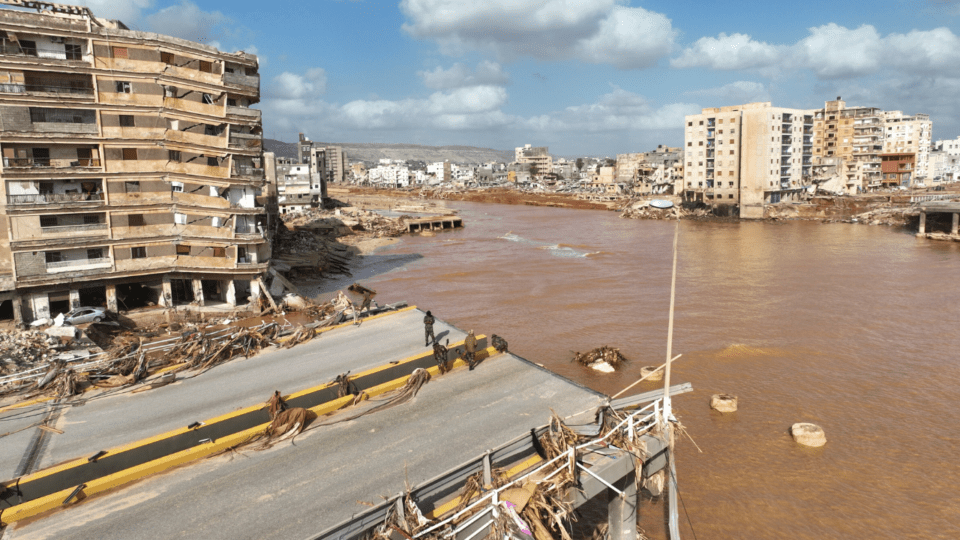In the aftermath of a devastating flood triggered by breached dams and relentless rains, the brave emergency responders in eastern Libya have made a heart-wrenching discovery. Over 1,500 bodies have been found amid the wreckage of Derna, with an astonishing 10,000 people still missing, leaving the death toll in Derna at a staggering 5,300. This tragic figure stands in stark contrast to earlier estimates, which had pegged the toll at 2,300, underscoring the sheer scale of this calamity.
The catastrophic impact of the Mediterranean storm Daniel not only showcases the relentless force of nature but also lays bare the vulnerabilities of a nation that has endured more than a decade of turmoil. Libya, riven by competing governments, has seen crucial infrastructure neglected in numerous regions.
Heart-wrenching images from the disaster zone paint a grim picture. Hospital yards are strewn with bodies covered by blankets, and mass graves are filled with victims. As of Tuesday evening, half of the recovered corpses had been laid to rest, but the true death toll is expected to climb into the thousands. Tamer Ramadan, Libya’s envoy for the International Federation of Red Cross and Red Crescent Societies, grimly suggests that at least 10,000 people remain unaccounted for, and over 40,000 have been displaced from their homes.
Comparing the dire situation in Libya to the recent earthquake in Morocco, Ramadan underscores the profound devastation wrought by the catastrophe. The disaster struck Derna and other parts of eastern Libya on a fateful Sunday night. As the storm relentlessly pounded the coast, the collapse of dams outside Derna unleashed flash floods along Wadi Derna, a river coursing through the city from the mountains to the sea.
Residents like Ahmed Abdalla, who witnessed the disaster, describe the wall of water as having “erased everything in its way.” Videos shared by residents online depict vast areas transformed into a sea of mud and wreckage, with neighborhoods on both riverbanks, swept away. Multi-story apartment buildings, previously set back from the river, saw their facades torn off, and concrete floors crumbled. Vehicles, carried away by the relentless floodwaters, were left piled atop one another.
In Derna, Mostafa Salem, who tragically lost 30 of his relatives, recounts the harrowing experience: “Most people were sleeping. Nobody was ready.” On a flight from Tripoli to the east, passenger Karim al-Obaidi expressed his fear and loss, saying, “I have never felt as frightened as I do now… I lost contact with all my family, friends, and neighbors.”
The National Meteorological Center of Libya claims to have issued early warnings for the “extreme weather event” of Storm Daniel 72 hours before its arrival, urging government authorities to take preventive measures. Bayda, another city in Libya, recorded an unprecedented 16.3 inches of rainfall from Sunday to Monday.
Local emergency responders, including troops, government personnel, volunteers, and courageous residents, worked tirelessly to locate the deceased on Tuesday. Inflatable boats were deployed to retrieve bodies from the water, with many believed to be trapped under debris or carried into the unforgiving waters of the Mediterranean Sea, as revealed by eastern Libya’s health minister, Othman Abduljaleel.
Abduljaleel stressed that the scale of destruction was beyond the capacity of Derna and the government, and external aid was urgently needed. Red Crescent teams from various parts of Libya arrived in Derna on Tuesday morning, yet additional excavators and equipment were still en route.
Although flooding during Libya’s rainy season is not unusual, it rarely results in such extensive devastation. Questions have arisen regarding how the rains managed to breach two dams outside Derna, whether due to poor maintenance or the sheer volume of rainfall.
Karsten Haustein, a climate scientist and meteorologist at Leipzig University, suggests that Storm Daniel unleashed an unprecedented 15.7 inches of rain on eastern Libya in a short span, possibly overwhelming the region’s infrastructure and causing dam failures. Haustein also notes that human-induced increases in water surface temperatures may have intensified the storm.
Derna had long suffered from the negligence of local authorities, with maintenance consistently postponed. Factionalism further complicated matters, as Derna had been under the control of Islamic militant groups for several years, straining its relationship with the eastern Libya government.
Despite the ongoing rivalry between Eastern and Western governments in Libya, the initial response to the disaster did witness some cooperation. The Tripoli-based government dispatched aid to Benghazi and allocated funds for reconstruction in eastern towns. Humanitarian aid and rescue teams from Egypt, Turkey, and the United Arab Emirates also arrived in Benghazi, with several other countries pledging their assistance.
As eastern Libya grapples with this unprecedented tragedy, it is painfully evident that the nation’s unity and resilience will face an immense test in the wake of such a devastating natural disaster.
As an independent media platform, we do not take advertisements from governments and corporate houses. It is you, our readers, who have supported us on our journey to do honest and unbiased journalism. Please contribute, so that we can continue to do the same in future.

